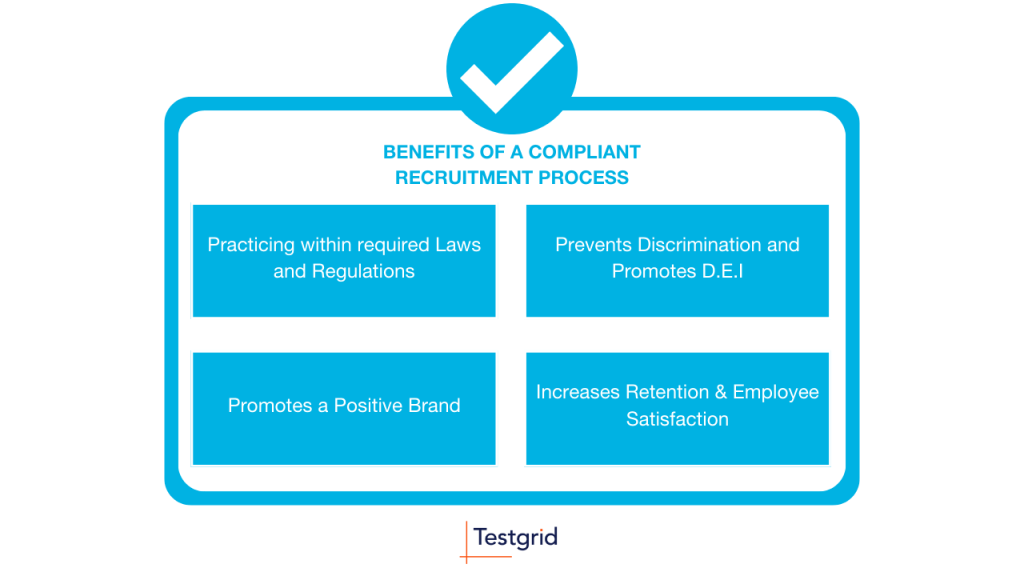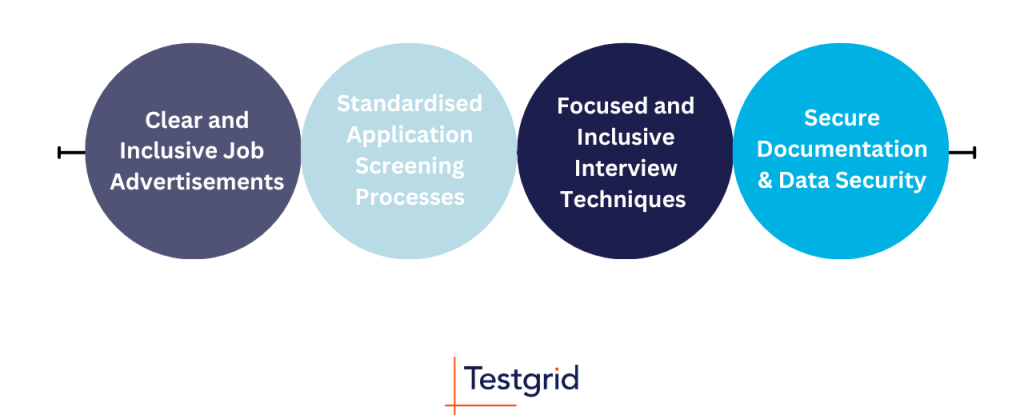How Compliant is your Recruitment Process?
With the after effects of the Covid-19 pandemic beginning to subside and the employment market continuing to evolve, ensuring your organisation upholds a compliant recruitment process following all current legal requirements and best-practices is paramount to positioning yourself in this competitive hiring landscape.
Luckily, there are a lot of incentives to encourage organisations to remain compliant and up to date, with many benefits associated with its effective implementation, as well as heavily detrimental drawbacks where it may be lacking.
In this blog, we’re outlining all the important aspects that make up a compliant recruitment process and the key components every recruiter should note in its construction and implementation. We’re also going to introduce commonly used tools that can assist your organisation in achieving this success.
WHAT MAKES A RECRUITMENT PROCESS COMPLIANT?
At its core, recruitment compliance is about ensuring organisations follow legal and ethical standards when hiring new employees.
These are ever changing and require constant attention when implementing recruitment strategy. The Anti-Discrimination and Human Rights Legislation Amendment (Respect at Work) Act introduced in 2022 as an example. Organisations will need to focus on optimising their recruitment process for these changes, an area we’ve provided some insight on in our blog here.
Recruiters must ensure they are abiding by all required local laws and regulations around recruitment practice as well us keeping up to date with expected best practices by current job seekers, showcasing an intention to creating a non-discriminatory and modern recruitment process.
BENEFITS OF A COMPLIANT RECRUITMENT PROCESS

There are a number of benefits that come with a compliant recruitment process. Let’s break them down into a few key areas.
Practicing within required Laws and Regulations
- The most obvious advantage of a formulating a compliant recruitment process is its ability to ensure your organisation is operating in accordance with all relevant laws and regulations. Keeping up to date with all legal obligations in recruitment/employment ensures your organisation’s practices are legally defensible, protecting you from any legal liability, fines, and any other penalties.
Prevents Discrimination and Promotes D.E.I
- Recruitment compliance primarily intends on helping organisations construct a non-discriminatory process with limited bias, ensuring that you’re not knowingly or unknowingly offending your candidates or violating their rights in any way.
- This results in an expanded candidate pool of more diverse talent, allowing equal opportunities for potential candidates. This plays a key role in presenting your organisation’s Diversity, Equity and Inclusion practices at the beginning of a candidate’s engagement (an area considered of primary importance to Millennial and Gen Z job seekers).
Promotes a Positive Brand
- Subsequently, a non-discriminatory recruitment process means your organisation is promoting a more inclusive and positive brand. With the importance of a strong brand trending through 2024, showcasing your organisation’s favourability goes a long way to creating a high volume and high-quality candidate pool.
Increases Retention & Employee Satisfaction
- A compliant recruitment practice even helps to future proof your hires, proving to increase employee retention and satisfaction, resulting in higher productivity and engagement. The first few weeks of a candidate’s engagement with your organisation can pave the way for a longer employment lifecycle, helping to avoid the resulting 20% of staff turnover that can occur within the first 45-days of a candidates employment where they had a bad first impression.
IMPACTS OF A NON-COMPLIANT RECRUITMENT PROCESS

On the other end of things, there are a number of major drawbacks to a lacking recruitment process. Some of these have lasting effects and can cause crippling damage to an organisation’s future hiring success.
Candidates Taking Legal Action
- An out-of-date recruitment process that fails to uphold legal requirements can result in candidates who report a bad experience taking legal action against your organisation. The legal risks associated with hiring can be very complex and should be considered carefully, something we’ve broken down in depth in our blog here.
Damaged Organisational Reputation
- A non-compliant recruitment process can be very detrimental to your organisation’s reputability. Bad candidate experiences resulting in bad reviews can lead to your organisation looking far less attractive than its competitors. Research indicates that 50% of job seekers won’t invest in an organisation with a bad reputation, showcasing that an organisations favourability has never been more paramount.
Diminished Attraction & Candidate Dissatisfaction
- With Gen Z taking their first steps into the current workforce, it’s important to note that over 50% of these applicants are not interested in recruitment processes that are outdated.
- If your organisation’s recruitment process is non-compliant and out of date, more of your pipeline are likely to ‘give up’ early with fewer candidates likely to maintain their position through your remaining stages.
Increased Recruitment Costs
- A non-compliant process can even impact your organisation financially, costing anywhere from $3,000 – $18,000 to replace any bad hires or early ‘quitters’. A new hire who has a bad experience with their first 90-days of engagement with your organisation are more likely to leave, resulting in your organisation having to spend more of your resources to replace them.
KEY COMPONANTS OF A COMPLIANT RECRUITMENT PROCESS
Now that we’ve explored the value of a remaining compliant, let’s look at the key components that make up a compliant end-to-end recruitment process. Here are some of the major areas your organisation can focus on.

Job Descriptions and Advertisements
- As one of the first interactions a candidate will have with your organisation, a positive experience with a Job Description/Advertisement paves the way for a candidate’s investment in applying. As it is generally very publicly available, it is arguably the most important area to focus on when upholding compliance.
- Creating a compliant job advertisement should focus on using concise and inclusive language that does not discriminate against any ethnic groups, age levels, genders, or minority groups. Indicating any physical expectations, qualifications or skill requirements clearly ensures you are attracting candidates most able to fulfil the expected role, however it is important to also provide reasonable accommodation where possible for those less able.
Application and Screening Processes
- Your application process and screening stages should be standardised and allow for equal opportunity. With the growing inclusion of technology in recruitment, there is little excuse for a recruitment process that is not consistent across high volume candidate pools.
- To help create equal opportunity, the hiring journey should ask the right questions of every candidate applying for the same role.
- Any pre-employment assessments used should also be standardised, while continuing to maintain a level of reasonable accommodation for less able candidates.
Interviewing Techniques
- Often being the first time a candidate is able to come face-to-face with your organisation, your interview stage should continue to showcase your organisations inclusivity and positive brand.
- It is important to create structured interview questions that are skills focused and relevant to the role and are not personally intrusive or discriminatory. Avoid any questions about a candidate’s gender, disability, ethnicity, age, marital status or number of children.
- Much like prior stages, it is important however to continue to provide reasonable accommodations to allow less able candidates equal opportunity to showcase their fit for a role.
Documentation & Data Security
- A component important throughout all stages of the process, maintaining detailed records of your candidate’s application process allows you to effectively defend your processes integrity and make strategic changes based on its impact and effectiveness.
- Alongside this, protecting candidate data also plays a substantial role in recruitment compliance. Knowing how to protect your candidate’s information can prevent costly data breaches and keep you up to date with modern security measures.
TOOLS TO HELP YOUR PROCESS BECOME MORE COMPLIANT
When it comes to maintaining compliance, there are a large variety of tools that any organisation can use to help optimise a recruitment process. As technology continues to play a key role in modern day recruitment, lets take a lot at some of the main tools that can help.
Applicant Tracking Systems (ATS)
- A primary tool in automating and standardising any hiring process, Applicant Tracking Systems let you organise candidate data, automate time-consuming administrative tasks, reduce time to hire, improve your candidate experience and create consistent and effective branding.
- ATS tools can help optimising every stage of the hiring process, including job advertisements & sourcing, screening processes and assessments, and standardising all candidate communications.
Pre-Employment Psychometric Testing
- Pre-Employment Testing and Psychometric Testing have become a staple in a high-quality recruitment process, especially in high volume hiring environments. Ranging from Cognitive Ability testing, Personality and Behavioural testing, Emotional Intelligence testing, and even Skills and Job Specific testing.
- One of the best measures of a candidates predicted on the job performance and fit within your organisations culture, pre-employment testing takes a lot of the guesswork out of recruitment and provides an honest and valid measurement of a candidate’s job fit. They also assist in creating unbiased data that can help compare a candidate’s overall application during the selection process.
Background Checking Services
- Much like Pre-Employment testing, Background Checking Services let you collect more valuable data on a candidate’s background prior to engaging with your organisation.
- Police checks, criminal record checks, identity verification, Australian work entitlement (VEVO) checks, identity fraud checks, reviewing criminal databases, online identity checks, reference checks, credit checks, and credit scores are just a few examples of background checks typically performed in Australia.
Video Interviewing Platforms
- Video interviewing is becoming more commonly recognised as a highly beneficial tool in recruitment, primarily due to its ability to reduce recruiter workload and access a much broader candidate pool without geographical limitation.
- Video Interview technology lets you create customisable structured interview processes that can be completed whenever and wherever the candidate is able, making your recruitment process far more accessible to a more diverse candidate pool. This technology also assists in reducing unconscious bias, creating role specific questions that are consistent across all candidates, making your interview process more inclusive.
Record Keeping & Data Management Tools
- More commonly referred to as Human Resource Software tools, these programs help an organisation manage employee data, automate and standardise payroll processes, monitor employee attendance and leave allowances, and assist overall with employee onboarding programs.
- With the first few weeks of a new employees exposure playing a key role in whether or not they stick around, it’s important to create a structured, consistent and informative onboarding process that educates employees on their new role. These tools can drastically improve these processes.
CONCLUSION
In the dynamic landscape of today’s recruitment, the significance of a compliant recruitment process cannot be overstated. As organisations vie for talent, ensuring your process is up to date with all legal requirements and best practices becomes the bedrock of success.
A compliant recruitment process is not just a legal requirement, it is also strategically imperative. It paves the way for attracting top talent, nurturing diversity, and reducing bias. As the recruitment landscape evolves, organisations must remain agile, embracing compliance as a dynamic force propelling them toward future success.
GET IN TOUCH
If you want to talk to one of our experts about making your recruitment process more compliant, get in touch with our team here, or call 03 9040 1700 to learn more.
